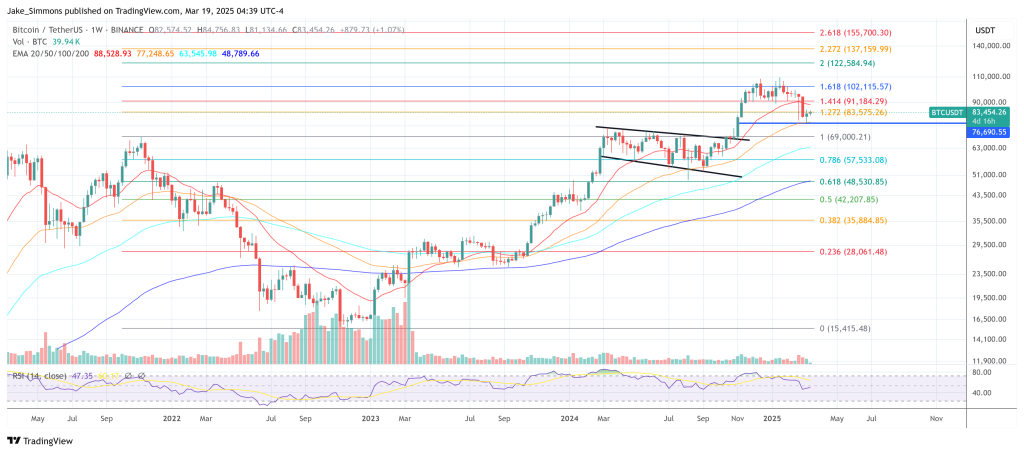Michael Saylor’s latest move to finance more Bitcoin purchases has reignited debate over the viability of his high-stakes approach. The corporate now called Strategy (formerly MicroStrategy) announced it will issue a recent perpetual preferred stock, STRF (“Strife”), at a ten% annual dividend. While some see this as an inventive strategy to accumulate more BTC, others warn the money dividend obligations could turn into untenable if Bitcoin prices plummet.
Could Saylor Be The Next Bitcoin Bear Market Catalyst?
On X, Strategy announced the creation of STRF (Strife), which it described as a “recent perpetual preferred stock offering, available to institutional investors and choose non-institutional investors.” In its statement, the corporate explained that proceeds would go toward general corporate purposes—including working capital—“and the acquisition of Bitcoin,” even though it stressed this remained “subject to market and other conditions.”
In response to Strategy, STRF carries cumulative dividends of 10% annually, with the primary money dividend scheduled for June 30, 2025, after which each quarter thereafter. Observers quickly noted how such a high payout could strain the firm’s resources, on condition that its balance sheet is heavily tilted toward Bitcoin slightly than traditional revenue streams.
Among the many early critics was WhalePanda (@WhalePanda), co-host of the Magical Crypto Friends YouTube channel with Riccardo Spagni, Samson Mow, and Charlie Lee. He argued the ten% dividend, which could amount to $50 million in annual payouts if Strategy raises $500 million, is simply too large given the corporate’s structure:
“I’ve said it before that Saylor goes to bring the following Bitcoin bear market. This seems desperate. 10% dividend on $500 million translates to $50 million annually, payable solely in money… they don’t have that money.”
One other vocal critic, Simon Dixon—an ex-investment banker turned Bitcoin investor known for backing platforms like Kraken, Bitfinex, and BitStamp—drew a pointy parallel between Strategy’s daring move and the notorious collapse of Long-Term Capital Management (LTCM) within the late Nineties. Although not equating the 2 scenarios outright, Dixon argued that offering such a high fixed dividend from “insufficient dollar revenue” resembled a “next-level risk.”
He cautioned: “Strategy’s announcement of a perpetual 10% dividend paid in dollars—despite lacking sufficient dollar revenue & operating with a Bitcoin-based balance sheet—is next-level risk. That is beginning to resemble Long-Term Capital Management, which required a bailout. If this ship sinks, nationalization might turn into a strategic move for the US government. For clarity, this doesn’t change my thesis on Bitcoin.”
Not everyone shares the dire outlook. Some industry figures insist that Saylor’s track record in growing Strategy’s BTC reserves—and the relative simplicity of its balance sheet in comparison with LTCM—offers a considerable cushion. David Bailey, CEO of BTC Inc, argued that Saylor’s personal commitment to Bitcoin mustn’t be discounted: “Saylor literally has more skin in the sport than anyone alive… In case you don’t just like the stock, don’t buy it, easy.”
He referred to critics as “ungrateful,” underscoring how Saylor’s public advocacy and company purchases have brought mainstream attention—and considerable inflows—to Bitcoin. Bitcoin analyst Dylan LeClair also dismissed the LTCM comparison, calling it “literally nothing like LTCM” and implying that Strategy’s BTC-backed balance sheet doesn’t pose the identical systemic risk as a heavily leveraged hedge fund dealing in derivatives.
Preston Pysh, co-founder of The Investor’s Podcast Network, offered a more nuanced take. While he expressed reservations concerning the recent issuance—questioning why Strategy didn’t utilize “the previous preferred issuance which has an 8% dividend yield and optionality for payments in common or money”—he viewed direct parallels to LTCM as “excessive laughable.”
Pysh floated rough numbers suggesting that even when Bitcoin were to tumble 70% from its current levels, Strategy could theoretically maintain dividend and coupon payments for greater than a decade. He wrote:
“If the worth of Bitcoin went down 70% from here, he still has 12 billion USD value of Bitcoin on the balance sheet and 115M in annual CASH payments (dividends and coupons combined) that must be paid. That’s roughly 12 years value of payment inventory on the balance sheet even with a 70% reduction in BTC’s value. Now this math is amazingly rough and I’ve put about 2 minutes value of effort into debunking this, so take it for what it’s value, but I feel your claim is hyperbolic.”
At press time, BTC traded at $83,454.

Featured image created with DALL.E, chart from TradingView.com

Editorial Process for bitcoinist is centered on delivering thoroughly researched, accurate, and unbiased content. We uphold strict sourcing standards, and every page undergoes diligent review by our team of top technology experts and seasoned editors. This process ensures the integrity, relevance, and value of our content for our readers.